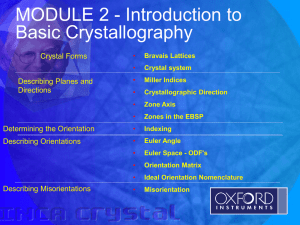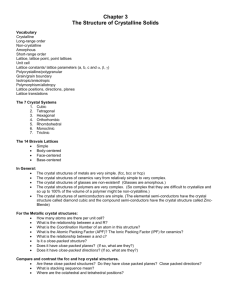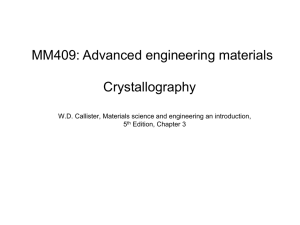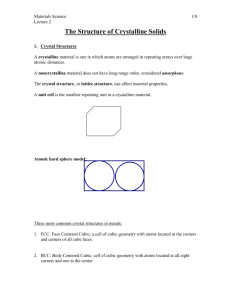Chap 3 Learn Obj
advertisement
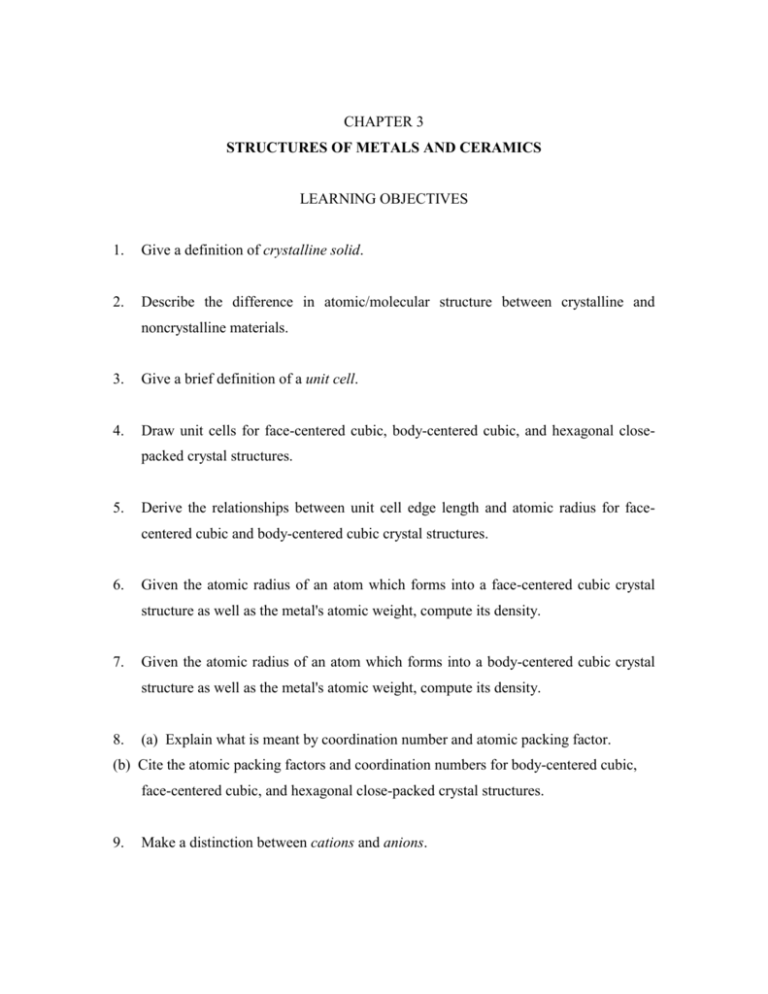
CHAPTER 3 STRUCTURES OF METALS AND CERAMICS LEARNING OBJECTIVES 1. Give a definition of crystalline solid. 2. Describe the difference in atomic/molecular structure between crystalline and noncrystalline materials. 3. Give a brief definition of a unit cell. 4. Draw unit cells for face-centered cubic, body-centered cubic, and hexagonal closepacked crystal structures. 5. Derive the relationships between unit cell edge length and atomic radius for facecentered cubic and body-centered cubic crystal structures. 6. Given the atomic radius of an atom which forms into a face-centered cubic crystal structure as well as the metal's atomic weight, compute its density. 7. Given the atomic radius of an atom which forms into a body-centered cubic crystal structure as well as the metal's atomic weight, compute its density. 8. (a) Explain what is meant by coordination number and atomic packing factor. (b) Cite the atomic packing factors and coordination numbers for body-centered cubic, face-centered cubic, and hexagonal close-packed crystal structures. 9. Make a distinction between cations and anions. 10. Cite two features of the component ions that determine the crystal structure of a ceramic material. 11. Sketch/describe unit cells for sodium chloride, cesium chloride, zinc blende, fluorite, and perovskite crystal structures. 12. Given the chemical formula for a ceramic compound, the ionic radii of its component ions, and, using Table 12.4, predict the crystal structure. 13. For a ceramic material which crystal structure may be generated from the stacking of close-packed planes of anions, given which type of interstitial positions (tetrahedral or octahedral) are occupied with cations, do the following: (a) specify what fraction of these sites are filled, and (b) note the occupied interstitial positions between two close-packed planes drawn as stacked one upon the other. 14. For an ionic compound having one of the crystal structures discussed in this chapter, be able to compute its density given the atomic weights of the constituent elements, the unit cell edge length, and Avogadro's number. 15. Given the unit cell for some crystal structure, be able to draw the atomic/ionic packing arrangement for a specific crystallographic plane. 16. Draw and describe the basic structural unit for the silicate ceramics. 17. Schematically diagram the atomic structure of a silica glass. 18. Sketch (or describe) the following: (a) a unit cell for the diamond cubic crystal structure, (b) the atomic structure of graphite, (c) the structure of a C60 fullerene molecule, and (d) the structure of a carbon nanotube. 19. Briefly define polymorphism (or allotropy). 20. Distinguish between crystal system and crystal structure. 21. Recognize and also give the lattice parameter relationships for all seven crystal systems--i.e., cubic, hexagonal, tetragonal, rhombohedral, orthorhombic, monoclinic, and triclinic. 22. Given a unit cell and three point coordinates, locate the point represented by these indices within the unit cell. 23. Given the location of a point within a unit cell, specify its point coordinates. 24. Given three index integers, sketch the direction corresponding to these indices within a unit cell (for all crystal systems). 25. Given a direction that has been drawn referenced to a unit cell (for all crystal systems), specify its direction indices. 26. Given a unit cell and the Miller indices for a plane, draw the plane represented by these indices referenced to this unit cell. 27. Specify the Miller indices for a plane that has been drawn within a unit cell. 28. Given a plane which has been drawn referenced to a hexagonal unit cell, specify its Miller-Bravais indices. 29. For hexagonal crystals, be able to convert both directional and planar indices from the three-axes scheme to the four-axes (Miller Bravais) scheme. 30. Given the unit cell for some crystal structure, be able to draw the atomic/ionic packing arrangement for a specific crystallographic plane. 31. Define both linear and planar atomic densities. 32. For a given crystal structure, be able to determine the linear density for a specified crystallographic direction. 33. For a given crystal structure, be able to determine the planar density for a specified crystallographic plane. 34. (a) Draw the packing of a close-packed plane of spheres (atoms). (b) Describe how both hexagonal close-packed and face-centered cubic crystal structures may be generated by the stacking of close-packed planes of atoms. (c) Cite which planes in both hexagonal close-packed and face-centered cubic structures are close-packed. 32. For a ceramic material which crystal structure may be generated from the stacking of close-packed planes of anions, given which type of interstitial positions (tetrahedral or octahedral) are occupied with cations, do the following: (a) specify what fraction of these sites are filled, and (b) note the occupied interstitial positions between two close-packed planes drawn as stacked one upon the other. 35. Distinguish between single crystals and polycrystalline materials. 36. Define grain boundary. 37. Define isotropy and anisotropy with respect to material properties. 38. Briefly describe the phenomenon of diffraction. 39. Given the angle at which an x-ray diffraction peak occurs, as well as the x-ray wavelength and order of reflection, compute the interplanar spacing for the crystallographic planes that are responsible for the diffraction peak. 40. For crystals having cubic symmetry, given the lattice parameter (i.e., unit cell edge length), compute the interplanar spacing for a set of crystallographic planes of specified Miller indices. 41. Schematically diagram the atomic structure of a silica glass.

